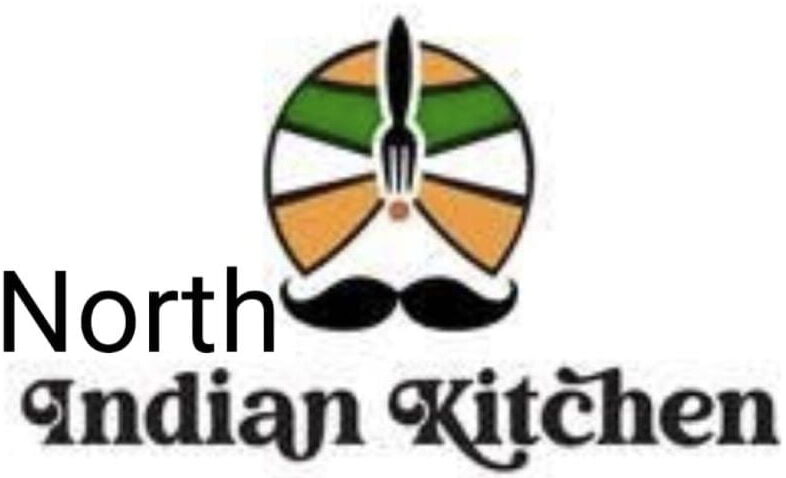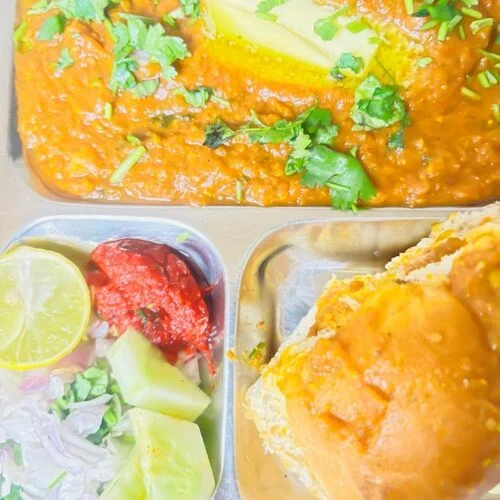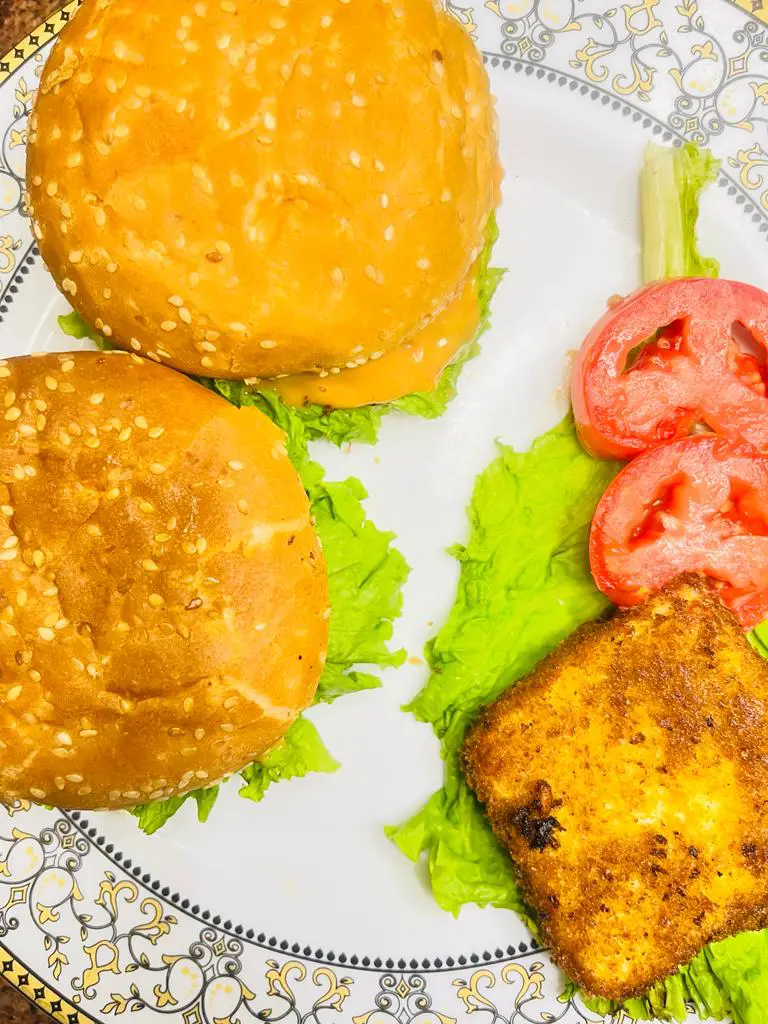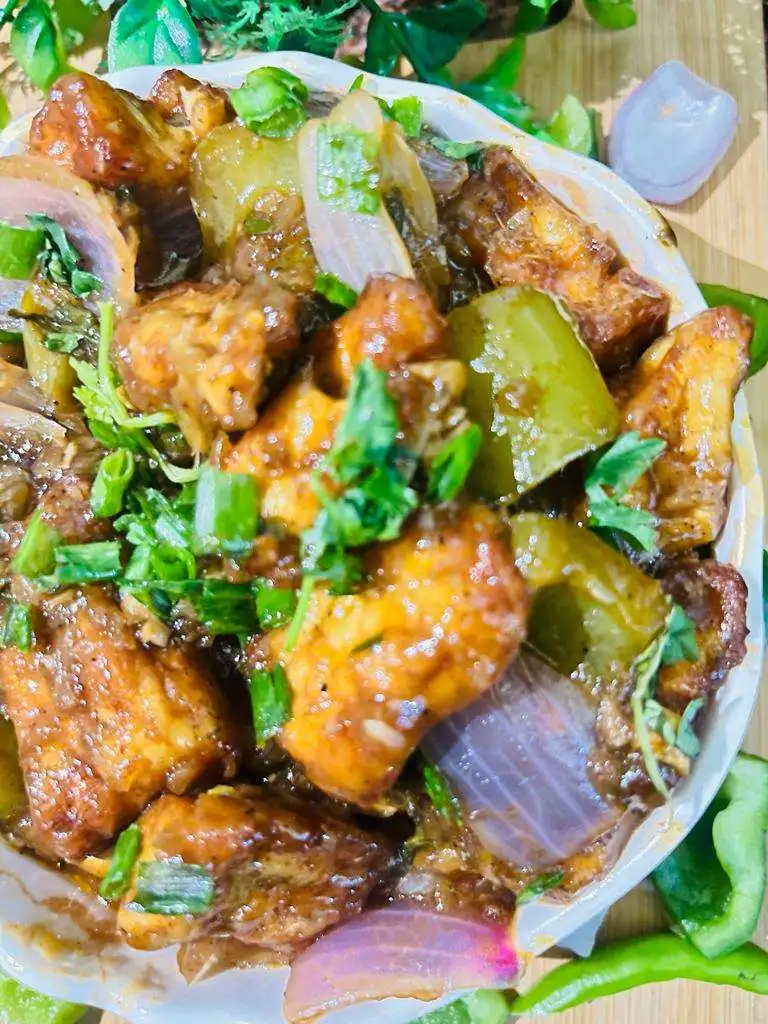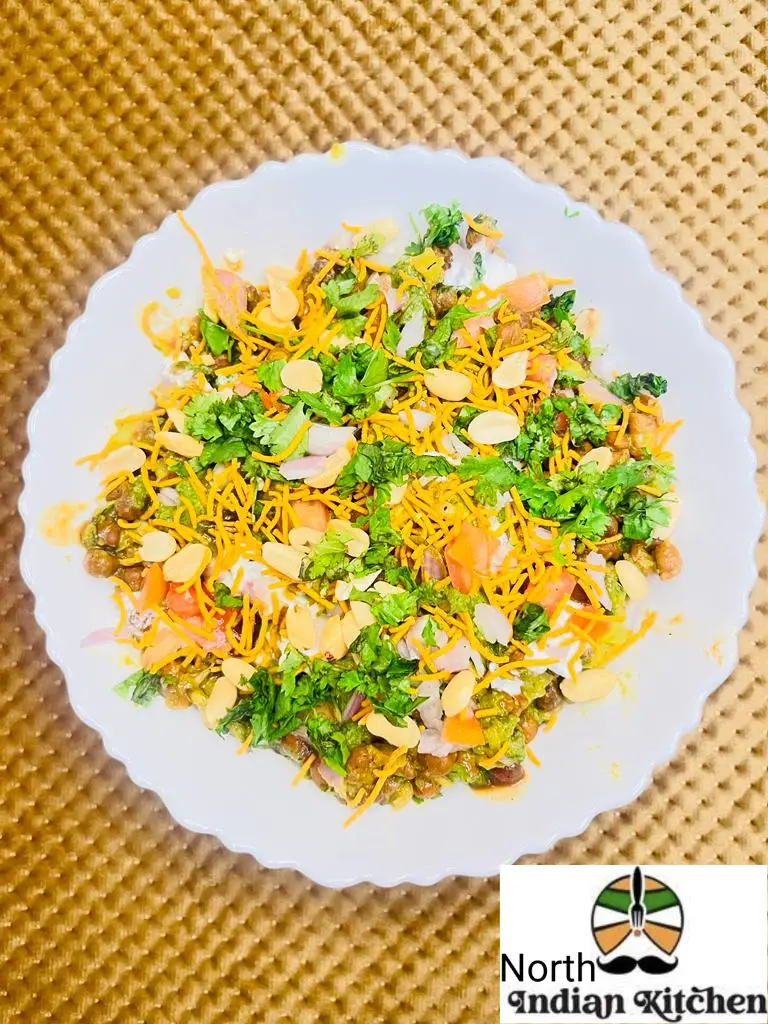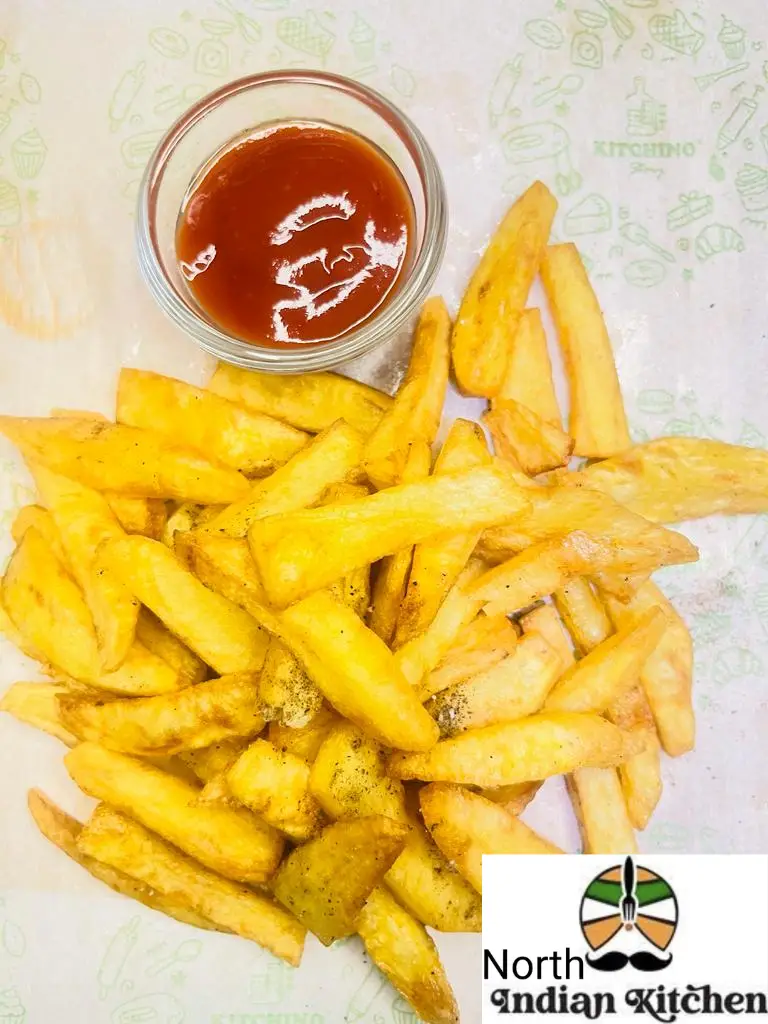Pav Bhaji | How to make Pav Bhaji at Home
Pav Bhaji is a popular street food dish from Maharashtra, India. It consists of a flavorful and spicy vegetable curry (bhaji) served with soft buttered buns (pav). The dish originated in Mumbai but has gained immense popularity across India and even worldwide.
The name “Pav Bhaji” literally translates to “bread and vegetables.” It is a perfect blend of various vegetables cooked with a special blend of spices, resulting in a rich and savory curry. The bhaji is typically made using potatoes, tomatoes, onions, peas, capsicum (bell peppers), and cauliflower, although variations with other vegetables are also common.
Pav Bhaji is enjoyed as a hearty and filling street food snack or even as a complete meal. It is a popular choice among people of all ages and is often served at food stalls, restaurants, and even at home for casual get-togethers or parties. The combination of Pav Bhaji with beverages like kulukki sarbath, rooh afza, cucumber mint cooler, masala soda & jaljeera.
The combination of the spicy, tangy, and buttery flavors of the bhaji with the soft and buttery pav makes Pav Bhaji a truly delicious and satisfying culinary experience.
What is Pav Bhaji
If you do have any mutter paneer leftovers, refrigerate in an airtight container for 1 to 2 days. The curry will thicken for 1 to 2 days. the curry will thicken after cooling and so while reheating , add a bit of water to lossen the consistency
Pav Bhaji is an iconic dish from mumbai, which is also hugely popular as street food all over india. It first came into picture in mumbai as a quick lunch option for textile worker. It is a flavorful and spicy vegetable curry served with soft bread rolls called pav.
Pav Bhaji is a popular Indian street food dish that originated in Maharashtra, particularly Mumbai. It is a flavorful and spicy vegetable curry served with soft bread rolls called pav.
The dish consists of two main components: the bhaji (vegetable curry) and the pav (bread rolls). The bhaji is made by boiling and mashing a variety of vegetables such as potatoes, tomatoes, peas, carrots, cauliflower, and bell peppers. The mashed vegetables are then cooked with a mixture of spices, including pav bhaji masala, red chili powder, turmeric, cumin, and coriander. This combination of spices gives the bhaji its distinctive and aromatic flavor.
The bhaji is typically cooked on a flat griddle (tawa) with a generous amount of butter, which adds richness to the dish. It is continuously mashed and mixed on the griddle, allowing the flavors to blend together and develop a thick and luscious texture.
The pav, which is an essential part of pav bhaji, is a soft and slightly sweet bread roll. The pav is sliced horizontally and toasted with butter on the same griddle until it becomes warm, slightly crispy, and buttery.
To serve pav bhaji, the bhaji is plated with a generous dollop of butter on top and garnished with finely chopped onions, coriander leaves, and a squeeze of lime or lemon juice. The pav is served alongside the bhaji, allowing diners to scoop the bhaji onto the pav, creating a flavorful sandwich-like bite.
Pav Bhaji is known for its bold and tangy flavors, and it is often enjoyed as a quick and satisfying street food snack or a full meal. It has become immensely popular across India and is also served in many Indian restaurants worldwide.
Note: Pav Bhaji can be adapted to various tastes and preferences. Some variations may include additional ingredients such as paneer (Indian cottage cheese) or mushrooms, and the spice level can be adjusted according to individual preferences.
About My Recipe
Memories of my Pav Bhaji Recipe go back to the times when I was a teenager. At home, I would often make this lovely dish for my family, especially my sister who absolutely loved to have this meal.
It was also a ritual for us to gorge on this delicious snack whenever we planned an outing to Juhu Beach in Mumbai.
The most typical way to have it was to order plates of it, with a generous quantity of bhaji and 2 pavs at a time. And then to finish the bhaji, we would keep on ordering for more pavs until there was no more bhaji left!
While I was growing up, it was almost a celebratory occasion to savor Pav Bhaji and other Mumbai style street dishes especially at the Juhu Beach. That time with the most delectable food, wind in our hair and the sound of the gushing waves – I can never forget these!
More so, because it was the place from where I have picked up the fine tips, tricks and nuances of making this yummy recipe with a lineage of its own!
To make my version of the Pav Bhaji Recipe, specifically the bhaji, I sauté the onion, tomatoes and ginger-garlic paste in butter first. Later, I add the boiled and mashed vegetables to it, which is followed by the pav bhaji masala. Then, I simmer this gravy for some minutes and serve it steaming hot with pav, lightly toasted in butter.
The street vendors and restaurant cooks use a large, flat tawa (skillet) to make the Pav Bhaji Recipe. But when making at home, you can use a kadai (wok), skillet or a frying pan to make it.
Ingredients List For Pav Bhaji Recipe
Potatoes: Potatoes form the base of the bhaji. They are boiled, peeled, and mashed to give the dish its creamy texture.
Tomatoes: Fresh tomatoes add tanginess and contribute to the vibrant color of the bhaji. They are finely chopped or pureed.
Onions: Onions are usually chopped and sautéed before adding other ingredients to provide a savory flavor to the bhaji.
Peas: Green peas are a common addition to Pav Bhaji, adding sweetness and texture. You can use fresh or frozen peas.
Cauliflower: Cauliflower is another vegetable that is boiled and mashed along with the potatoes to create a smooth consistency in the bhaji.
Bell Peppers (Capsicum): Bell peppers, particularly green ones, are diced and added to the bhaji for a slightly crunchy texture and a mild flavor.
Pav Bhaji Masala: This is a key spice blend that gives Pav Bhaji its distinct taste. It typically includes a mix of spices like coriander, cumin, fennel seeds, black cardamom, cinnamon, cloves, and more. It can be found in Indian grocery stores or made at home.
Red Chili Powder: Red chili powder adds heat and spiciness to the dish. Adjust the amount according to your preference.
Turmeric Powder: Turmeric powder is used to add color and a subtle earthy flavor to the bhaji.
Garlic and Ginger: Freshly minced or grated garlic and ginger add a wonderful aroma and depth of flavor to the bhaji.
Butter: Butter is a crucial ingredient that gives richness and enhances the taste of Pav Bhaji. It is used for sautéing the onions and also added generously to the bhaji.
Lemon or Lime Juice: A squeeze of lemon or lime juice is added at the end to provide a tangy freshness to the bhaji.
Pav (Bread Rolls): Pav is a type of soft and slightly sweet bread roll. It is typically served with Pav Bhaji. You can either make your own pav or purchase them from a bakery.
Optional Garnishes:
Chopped Onions: Finely chopped onions are sprinkled on top of the bhaji for added crunch and flavor.
Fresh Coriander (Cilantro) Leaves: Chopped coriander leaves are used to garnish the bhaji, giving it a fresh and vibrant touch.
How to make Pav Bhaji
- Heat a frying pan or kadai (wok) You can also use a large tawa or a skillet. Add 2 to 3 tablespoons butter & oil. The butter can be salted or unsalted. Let the butter melt.
- Then add 1 cup chopped onions and Mix onions with the butter and saute on a low to medium heat and cook until they turn pinkish in colour.
- Further add capsicum and cook on high flame for 2-3 minutes.

- Now add the boiled & chopped veggies.

- Put salt, prepared pav bhaji masala, powdered spices & green chilli paste, mix it really well & try to break down the veggie chunks with spatula. Furthermore add prepared garlic and chilli paste, mix well and initially add 1-2 cups of hot water.

- Now use a pav bhaji masher and start to mash the bhaji really well, Keep the flame is low and mash until the bhaji is most crushed.

- You can adjust the consistency of the bhaji by adding additional hot water. I like the consistency of my pav bhaji to be little thin just like the street vendors do, you can adjust the consistency of the bhaji as per your preference.

The whole process of cooking will take about 15-20 minutes.
- The base of the bhaji is ready, let the bhaji simmer on low flame by the time you can make the tadka that needs to go on the bhaji.
- For tadka, set a pan on medium heat, add butter, prepared red chilli paste& garlic paste, pav bhaji masala and garam masala, cook on medium high flame for 1-2 minutes, further add the tadka into the bhaji &mix well.

Check for the seasoning and adjust the salt as per taste.
- Further add freshly chopped coriander leaves, butter and lemon juice, mix well and cook on medium heat for 2-3 minutes, your bhaji is ready to be serve with nice soft butter pav.

Pan Fry Pav
- When the bhaji is simmering, you can pan fry the bread rolls so that you serve the pav with steaming hot bhaji. Cut through the bread roll from the center so that you get two equal halves.
- Heat a tawa or skillet or a shallow frying pan. Keep the heat to a low and then add 1 to 2 tablespoons butter or more if you like.
- When the butter begins to melt, add 1 teaspoon of pav bhaji masala (for 2 to 3 pav). You can skip pav bhaji masala if you prefer.
- Mix the pav bhaji masala very well with a spoon or spatula.
- Then place the pav on the butter.

- Press with a spatula and rotate the pav all over the melted butter so that the pav absorbs the butter together with the ground spices.
- Now turn over the pav. Press gently with a spatula and rotate them on the tawa so that the second side absorbs the butter.
- Add more butter if needed. You can turn over and toast them more if required. Then transfer the lightly pan fried bread rolls in a plate and set aside. This way fry the rolls in two to three batches.
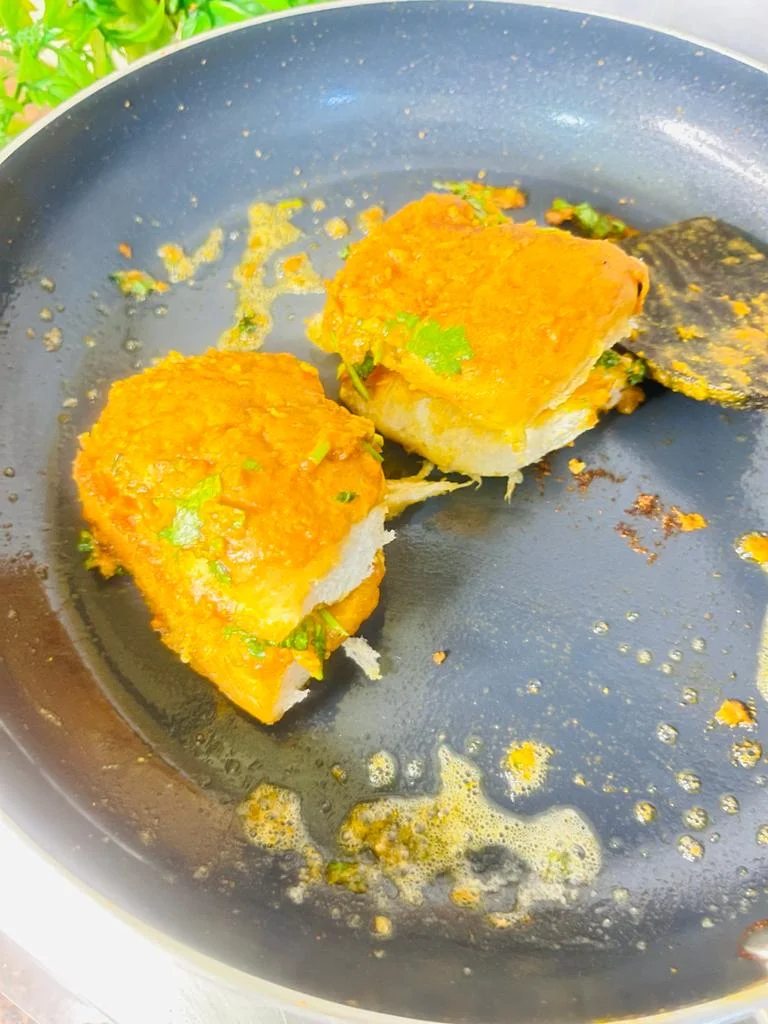
Serve piping hot Bhaji topped with a bit of butter paired with the lightly toasted pav and a side of finely chopped onions, coriander leaves and lemon wedges.
Mumbai pav bhaji served in a rectangular serving tray with buttered pav and chopped onions, coriander leaves and lemon wedges on a white table.
Serving Suggestions
Classic Style: Serve the Pav Bhaji in a plate or a bowl with a dollop of butter on top. Garnish it with finely chopped onions and fresh coriander (cilantro) leaves. Serve the hot and flavorful bhaji alongside buttered and toasted pav.
Pav Bhaji Sliders: Instead of serving the bhaji and pav separately, assemble mini sliders by placing a spoonful of bhaji between sliced and toasted pav. You can skewer them with toothpicks for easy serving.
Pav Bhaji Frankie/Roll: Spread a generous amount of the bhaji on a thin roti or tortilla, add some sliced onions, and roll it up like a wrap. This creates a delicious Pav Bhaji Frankie, perfect for a grab-and-go meal.
Pav Bhaji Pizza: Spread the bhaji as a topping on a pre-baked pizza crust. Add some grated cheese, sliced bell peppers, and onions. Bake until the cheese melts and the crust is crispy. Cut it into slices and serve it as a unique twist on pizza.
Pav Bhaji Tacos: Fill taco shells with the bhaji, and top it with shredded lettuce, diced tomatoes, grated cheese, and a squeeze of lime juice. Enjoy the fusion of Indian and Mexican flavors.
Pav Bhaji Fondue: Keep the bhaji warm in a fondue pot or a slow cooker. Serve it with buttered and toasted pav alongside skewers or toothpicks for dipping into the bhaji.
Pav Bhaji Bruschetta: Toast slices of baguette or crusty bread. Top them with a generous amount of bhaji, sprinkle with grated cheese, and broil until the cheese melts and gets bubbly. Serve as a flavorful appetizer or snack.
Pav Bhaji Salad: Create a salad by layering a bed of lettuce or mixed greens, adding a generous scoop of bhaji on top, and garnishing it with diced tomatoes, cucumbers, and onions. Drizzle some lemon juice or dressing of your choice.
Remember to serve Pav Bhaji hot and fresh. Accompany it with lemon wedges and additional butter on the side. It pairs well with a side of pickles, chutney, or raita (yogurt sauce) for added flavor.
Expert Tips
Vegetable Selection: Use a variety of fresh vegetables like potatoes, tomatoes, onions, peas, cauliflower, and bell peppers for a flavorful and nutritious bhaji. You can also add other vegetables like carrots or beans for added texture and taste.
Bhaji Consistency: Mash the boiled vegetables well to achieve a smooth and creamy texture for the bhaji. Ensure that all the vegetables are properly cooked and blended together to create a harmonious mix.
Spice Blend: Invest in a good-quality pav bhaji masala or make your own blend at home using a combination of spices like coriander, cumin, fennel seeds, black cardamom, cinnamon, cloves, and others. Adjust the spice level according to your taste preferences.
Butter Magic: Use a generous amount of butter for cooking the onions and in the bhaji itself. Butter adds richness and enhances the flavors of the dish. You can also top the bhaji with a dollop of butter before serving.
Cooking Technique: Cook the bhaji on a flat griddle (tawa) to ensure even heat distribution and to allow the flavors to develop and meld together. Continuously mash and stir the bhaji while cooking to achieve the desired consistency and flavors.
Toasted Pav: Toast the pav on the same griddle with a layer of butter until it becomes warm, slightly crispy, and buttery. This adds a delicious texture and enhances the overall taste of the dish.
Garnish: Garnish the Pav Bhaji with finely chopped onions, fresh coriander (cilantro) leaves, and a squeeze of lime or lemon juice. These toppings add freshness, crunch, and tanginess to the dish.
Simmering: After cooking the bhaji, let it simmer on low heat for a few minutes to allow the flavors to blend and intensify. This helps in developing a rich and flavorful bhaji.
Adjust Seasonings: Taste the bhaji before serving and adjust the seasoning if needed. You can add more pav bhaji masala, red chili powder, or other spices according to your preference.
Fresh Pav: Serve the Pav Bhaji with fresh and soft pav. You can either make your own pav or purchase them from a bakery. Ensure they are warm and buttered just before serving.
Accompaniments: Serve Pav Bhaji with a side of chopped onions, lemon wedges, and additional butter on the side. It pairs well with pickles, chutney, or raita for added flavor and variety.
Hot and Fresh: Serve Pav Bhaji hot and fresh to enjoy the flavors at their best. It is a dish that is best enjoyed immediately after preparation.
FAQs
Q. What is the origin of Pav Bhaji?
Pav Bhaji originated in Mumbai, Maharashtra, India. It was initially created as a quick and filling meal for textile mill workers in the 1850s. Over time, it gained popularity and became a beloved street food across India.
Q. Can I make Pav Bhaji without butter?
Butter is an essential ingredient in Pav Bhaji as it adds richness and enhances the flavors. However, if you prefer a healthier version, you can use a smaller amount of butter or substitute it with oil. Keep in mind that the taste and richness may slightly differ.
Q. Can I make Pav Bhaji without pav bhaji masala?
Pav Bhaji masala is a key spice blend that gives Pav Bhaji its distinctive flavor. It is recommended to use pav bhaji masala for an authentic taste. However, if you don’t have access to it, you can create a substitute by combining individual spices like coriander, cumin, turmeric, red chili powder, and garam masala in the right proportions.
Q. Can I make Pav Bhaji with frozen vegetables?
Yes, you can use frozen vegetables to make Pav Bhaji if fresh vegetables are not readily available. Just make sure to thaw them before using and adjust the cooking time accordingly. However, fresh vegetables generally provide better texture and flavor.
Q. Can I customize the spice level in Pav Bhaji?
Yes, you can adjust the spice level of Pav Bhaji according to your taste preferences. Add more or less red chili powder or green chilies to make it spicier or milder. Taste as you cook and make adjustments accordingly.
Q. Can I make Pav Bhaji ahead of time?
Pav Bhaji is best enjoyed fresh and hot. However, you can prepare the bhaji in advance and refrigerate it for a day or two. Reheat it on the stovetop or in the microwave before serving. The pav, however, is best toasted just before serving.
Q. What can I serve with Pav Bhaji besides pav?
Pav Bhaji is traditionally served with pav (bread rolls). However, you can also serve it with roti, naan, or even rice. It pairs well with a side of raita (yogurt sauce), sliced onions, lemon wedges, and pickles.
Q. Can I add meat or protein to Pav Bhaji?
Pav Bhaji is a vegetarian dish, but you can add additional protein if desired. You can add cooked and shredded paneer (Indian cottage cheese) or tofu for a vegetarian option. For non-vegetarian variations, you can add cooked and minced chicken or keema (minced meat) to the bhaji.
Q. Can I freeze leftover Pav Bhaji?
Pav Bhaji can be frozen, but the texture may slightly change upon reheating. It is best to consume it fresh, but if you have leftovers, cool them down, store them in airtight containers, and freeze them for up to a month. Thaw and reheat on the stovetop or in the microwave before serving.
Q. Can I make Pav Bhaji without onions and garlic?
Onions and garlic contribute to the flavor profile of Pav Bhaji, but if you have dietary restrictions or preferences, you can omit them. The dish may have a slightly different taste, but it can still be delicious with the other ingredients and spices.
You can try our other street food recipes now.
More Street Food Recipes
Please be sure to rate this recipe or leave a comment below if you have made it. For more veetarian inspirations, Sign Up for my emails or follow me on Instagram, Youtube, Facebook , Twitter or Pinterest.
Pav Bhaji Recipe Card
Equipments
Ingredients
Garlic Paste
- ¾ cup Garlic cloves
- Water as required
Boiling Veggies
- Boiling water
- 1 medium sized Cauliflower
- ¾ cup Green Peas
- A pinch of Turmeric powder (haldi)
- A pinch of Salt
Base Bhaji
- 50 gram Oil
- 2 tablespoon Oil
- 2-3 medium sized Onion (chopped)
- 2 medium sized Capsicum (chopped)
- 7-8 medium sized Potatoes (boiled & mashed)
- 7-8 medium sized Tomatoes (chopped)
- Boiled green Peas
- Boiled Cauliflower florets
- 1 medium sized Beetroot (boiled & grated)
- Fresh Coriander a handful (chopped)
- Salt to taste
- 2 tablespoon Prepared Pav Bhaji masala
- 1 teaspoon Kashmiri red chilli powder
- 1 tablespoon Dhaniya powder
- ½ teaspoon Turmeric (haldi) powder
- 1 teaspoon Kasuri methi
- Green Chilli paste (paste of 2 green chillies)
- 7-8 tablespoon Prepared Garlic paste
- 7-8 tablespoon Preapared Red chilli paste
- Hot water as required
For Tadka
- 50 gram Butter
- A pinch of Jeera seeds
- 4 tablespoon Prepared Red chilli paste
- 2 tablespoon Garlic paste/water
- 1 teaspoon Pav Bhaji masala
- A pinch of Garam masala
- Salt to taste
- Freshly chopped Coriander leaves
- 1 teaspoon Lemon juice
For Garnishing (optional)
- 100 gm Cheese
Instructions
- Heat a frying pan or kadai (wok) You can also use a large tawa or a skillet. Add 2 to 3 tablespoons butter & oil. The butter can be salted or unsalted. Let the butter melt.2. Then add 1 cup chopped onions and Mix onions with the butter and saute on a low to medium heat and cook until they turn pinkish in colour.3. Further add capsicum and cook on high flame for 2-3 minutes.4. Now add the boiled& chopped veggies.5. Put salt, prepared pav bhaji masala, powdered spices &green chilli paste, mix it really well. Furthermore add prepared garlic and chilli paste, mix well and initially add 1-2 cups of hot water.6. Now use a pav bhaji masher and start to mash the bhaji really well, Keep the flame is low and mash until the bhaji is most crushed.7. You can adjust the consistency of the bhaji by adding additional hot water.8. The whole process of cooking will take about 15-20 minutes.9. The base of the bhaji is ready, let the bhaji simmer on low flame by the time you can make the tadka that needs to go on the bhaji.10. For tadka, set a pan on medium heat, add butter, prepared red chilli paste& garlic paste, pav bhaji masala and garam masala, cook on medium high flame for 1-2 minutes, further add the tadka into the bhaji & mix well.11. Check for the seasoning and adjust the salt as per taste.12. Further add freshly chopped coriander leaves, butter and lemon juice, mix well and cook on medium heat for 2-3 minutes, your bhaji is ready to be serve with nice soft butter pav.Pan Fry Pav13. When the bhaji is simmering, you can pan fry the bread roll so that you serve the pav with steaming hot bhaji. Cut through the bread roll from the center so that you get two equal halves.14. Heat a tawa or skillet or a shallow frying pan. Keep the heat to a low and then add 1 to 2 tablespoons butter or more if you like.15. When the butter begins to melt, add 1 teaspoon of pav bhaji masala (for 2 to 3 pav). You can skip pav bhaji masala if you prefer.16. Mix the pav bhaji masala very well with a spoon or spatula. Then place the pav on the butter.17. Press with a spatula and rotate the pav all over the melted butter so that the pav absorbs the butter together with the ground spices.18. Now turn over the pav. Press gently with a spatula and rotate them on the tawa so that the second side absorbs the butter.19. Add more butter if needed. You can turn over and toast them more if required. Then transfer the lightly pan fried bread rolls in a plate and set aside. This way fry the rolls in two to three batches.Serve piping hot Bhaji topped with a bit of butter paired with the lightly toasted pav and a side of finely chopped onions, coriander leaves and lemon wedges.
Video
Notes
- The vegetables that are usually added are sturdy veggies like cauliflower, potatoes, carrots, peas, capsicum and french beans. In the pav bhaji that one gets in the streets of Mumbai, carrots are not added. But when you make at home, you can add carrots.
- You can also simply make bhaji with any of these veggie proportions but always keep the proportion of cauliflower less than the other veggies.
- Refrain from using veggies like okra, eggplants, radish, corn, yam or green leafy vegetables. Cabbage, broccoli, zucchini, pumpkin are some unique options that you can consider to add, but the traditional version does not include these vegetables.
